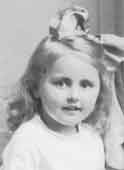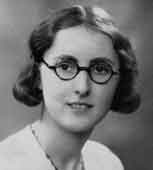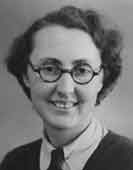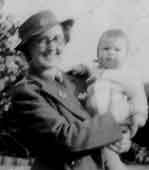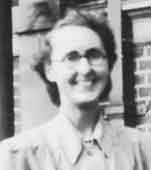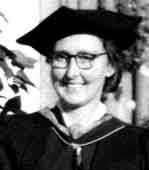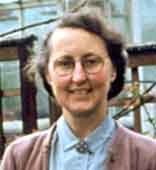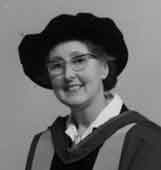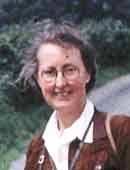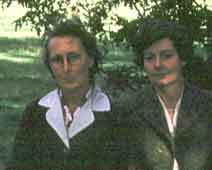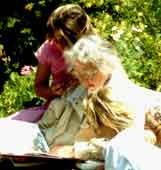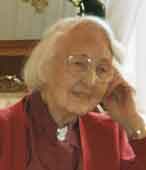Dr Winifred Dullforce is remembered by many former students of the Nottingham University School of Agriculture at Sutton Bonington for her competent, thorough and kind approach. They will have fond memories of her and that dynamic period of horticultural education.
Born in Essex in April 1916 Winifred Dullforce started her working career in newspaper publishing, but after the start of World War II she turned to the Women's Land Army. After the war she studied at several institutions including Studley College. By 1950 she was teaching at Sutton Bonington, becoming tutor and lecturer; gaining her NOH, degrees, masters and doctorate along the way.
Her written work was published widely, including in the journal of the International Society for Horticultural Science. She was renowned for her practical and wide-ranging knowledge and her ability to demonstrate horticultural techniques. She retired in 1977.
Winifred Dullforce was Vice-President of the Horticultural Education Association before it became the Institute of Horticulture, and was among those who helped to ensure a smooth transition.
Both before and since retiring she was active in Kegworth Village life (where she lived) having been involved in the establishment of the village hall (of which she was treasurer for many years) and, in later years, the setting up of the Kegworth Village Museum
Brian Self writes: Experience in the Womens' Land Army during World War II steered Winifred Dullforce from a career in journalism to one in horticulture. She studied at Studley College and was subsequently appointed to the staff of the University of Nottingham Horticulture Department at Sutton Bonington. Winifred developed a special interest in glasshouse crops and mainly lectured in this sphere. Her thirst for knowledge led to further attainments, gaining a Masters and a PhD, in addition to her NOH. In the 1950s and 1960s she was one of four lecturers in the department under the dynamic leadership of Professor John Hudson.
Winifred had a love of plants and an understanding of how to grow them. Former students will remember her dedicated approach to craftsmanship and precision growing; she was thorough and meticulous.
Two letters were read at Winifred's funeral from former students. One, from Barrie Machin, who undertook an external PhD following 13 years in the industry after graduating, wrote:
"I was fortunate that Winifred was appointed as my supervisor. She taught me basic statistics and showed how to design my experiments. I can never thank her enough for the unstinted help she gave me. Winifred was for me a 'first lady of horticulture'."
A second tribute, from TK (Sandy) Warley from Canada, a former Professor of Economics at the University of Guelf, Ontario, who graduated in 1953, said:
"You made me a genuine horticulturist. Your measured advice, high expectations and constant encouragement inspired me to succeed. Alas I 'went wrong' and was lost to professional horticulture by a growing interest in economics and business. But I've remained a life-long gardener and am still involved in the governance and operation of a therapeutic garden for folks with physical and cognitive disabilities".
Winifred had a wide interest in horticulture. She was closely involved with the Horticultural Education Association (REA), was editor of its journal, Scientific Horticulture, for eight years and served on its council (latterly as its Vice-President).
She kept in touch with many former Sutton Bonington students and enjoyed gatherings for her 90th and 92nd birthdays. She attended several of John Hudson birthday parties, travelling by taxi from Kegworth Village to Somerset.
Winifred had a long and busy retirement. She was involved with fund raising for Kegworth Village Hall, was its dedicated treasurer for 57 years, and was the driving force behind the establishment of Kegworth Village Museum. Her interests were associated with history, music and art. She was a skilled watercolourist and the walls of her home were lined with landscape paintings.
Editor's note: The IoH journal, The Horticulturist is a direct descendent of the HEA's Scientific Horticulture. Volume 36 of Scientific Horticulture was published in 1985 (the first year of the IoH) under a new title The journal of the Institute of Horticulture and its editor was Dr Winifred Dullforce, who had been responsible for producing Scientific Horticulture since 1977 (from archive notes by Desmond Day).
Ken, her nephew, adds: Win was born in Hornchurch, then in Essex, shortly before her father George went off to fight in World War I. The family moved to the North of England later, to be near George, who was evacuated with pleuresy. They returned to Clapham after. Win was educated at St. Marks Primary School & Clapham County Grammar School, before taking a job at the "Daily Express", where her father was Clerk of the Chapel of the "London General Trade Society of Compositors".
About 1950, she bought a house in Kegworth in North Leicestershire, close to the Sutton Bonnington campus of Nottingham University after having lived in digs. She remained there until, at the age of 92, she booked herself into a nursing home, "The Willows" in nearby Shepshed, which is where she died. Although rather deaf, she had her wits about her until the end. I used to take a stack of paper to write my half of the conversation.
Typically, she had renewed her passport at the age of 84...and used it. While apparently untouched by romance, she had a wide circle of acquaintance & while the no-nonsense attitude of the thorough scientist could occasionally be a bit abrasive in the family, it must have been a boon to civil societies trying to get ambitious projects off the ground in a small village, which they succeeded in doing.


